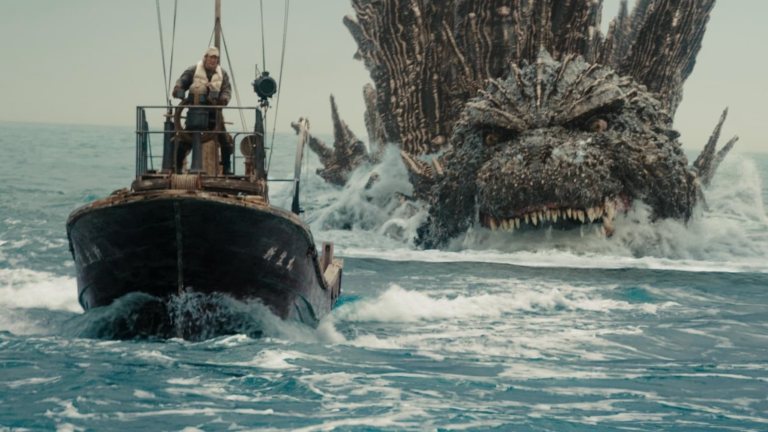Godzilla Minus One Review: Japanese Godzilla Remains King
The Big G returns to his roots in Godzilla Minus One, a Toho film about the abject horror of industrial scale warfare. Plus, Godzilla chases a boat like Jaws!

Unless he’s palling around with Minilla or Godzilla Jr., it’s hard not to see Godzilla as anything other than a 20,000-ton, fire-breathing metaphor. When used well, that symbolic weight crystalizes the terror of living in a world in which 100,000 people can have their lives snuffed out by atomic weapons. When used poorly, well, Godzilla fights a smog monster.
This tension between human weight and the sheer awesomeness of giant monsters has plagued all variations of the franchise since the first sequel to the 1954 original, Godzilla Raids Again (1955). More recently, it has stymied Legendary Pictures, the studio responsible for the lackluster MonsterVerse series, which includes 2014’s Godzilla and the current Apple TV+ series, Monarch: Legacy of Monsters. Time and again, the MonsterVerse distracts from their kaiju—excuse me, MUTOs—with dull human drama that not even charismatic performers such as Kurt Russell, Brian Tyree Henry, and Vera Farmiga can save.
Within its first minutes, Godzilla Minus One sidesteps that problem with a unique dilemma. The film opens on Odo Island in 1945 Japan where pilot Kōichi Shikishima (Ryunosuke Kamiki) sabotages his plane to avoid his kamikaze mission. When Godzilla attacks the island—here younger, smaller, more savage—fear grips Shikishima and prevents him from firing his plane’s guns at the monster, resulting in the death of most of his fellow soldiers.
More than a personal choice, writer and director Takashi Yamazaki frames Shikishima’s refusal to shoot as a matter of national honor. Upon returning to his war-ravaged community in Tokyo circa 1947, locals curse Shikishima for failing to do his duty and thus allowing the Allies’ devastation to continue. Even two years later, nightmares drive Shikishima to wonder aloud if he’s a ghost, trapped in a postwar hell as punishment for his cowardice.
Kamiki shines in these moments, immediately earning viewers’ sympathy with his troubled brow and burning eyes, suggesting rage against the war machine that too often sublimates into self-hatred. Even when teamed with the small crew of sailors hired to destroy ocean mines, or creating a found family with fellow survivor Noriko Ōishi (Minami Hamabe) and the abandoned child (Sae Nagatani), Kamiki plays the tension between the need for belonging and his inescapable guilt. Hamabe gets less to do as Noriko, a fairly one-note doe-eyed character reduced to supporting Shikishima through his PTSD, but she makes for a warm presence in a bleak setting.
Yamazaki’s film better serves co-stars Hidetaka Yoshioka, who plays engineer Dr. Noda, and Kuranosuke Sasaki and Yuki Yamada as Captain Akitsu and young trainee Mizushima, Shikishima’s shipmates aboard the Shinsei Maru. Yamazaki borrows heavily from Steven Spielberg’s Jaws in these sequences, combining the stress between the mismatched crew, particularly Mizushima’s disappointment that the war ended before he could enlist, with the camaraderie they quickly develop while blasting mines out to sea.
Compelling as the humans are, Yamazaki never lets them distract from the main event: Godzilla himself. Serving as visual effects director alongside Kiyoko Shibuya, Yamazaki gives us a Godzilla even more beefiness than his current American counterpart without losing the feel of a person in a rubber suit.
Unlike Toho’s last outing, the equally excellent Shin Godzilla (2016), the monster of Godzilla Minus One remains fundamentally dino-like, even in his earliest incarnation. But where the younger Godzilla had a fleetness that recalls the T-Rex of Jurassic Park, the mature monster thunders with unadulterated power. Yamazaki reimagines Godzilla’s atomic breath as a more machine-like buildup, with the scales on his back mechanically popping up as they turn blue. The sound cuts out when Godzilla releases his blue blast followed by a mushroom cloud at the point of impact, which decimates the surrounding area with a hurricane gust that first radiates out and then implodes in.
As that description suggests, Godzilla of Minus One once again represents the uncontrollable destruction of atomic weapons. But Yamazaki broadens the movie’s metaphorical view to link Godzilla to war in general, a seemingly unstoppable death dealer with no understandable motivation.
On one hand, this shift in perspective lets the U.S. off relatively easy. A quick shot of the atomic explosion at Bikini Atoll juxtaposes with an extreme close-up of Godzilla’s eye, establishing that U.S. testing mutated Godzilla into the hulking beast we know, but not that it created the monster in the first place. Characters briefly mention the dangers to civilians posed by magnetic mines left in the Pacific, but quickly turn their criticisms toward their own government. When the American military refuses to help Japan fight Godzilla for fear of arousing Soviet suspicions, the Japanese characters nod in understanding.
To the cynical, that shift reveals the commercial hopes of Godzilla Minus One, as Toho hopes to garner an audience among us easily offended Americans. However, the movie frames nationalism as part of the war machine that breeds death and destruction. For all of the horrific violence onscreen, Godzilla Minus One is an endlessly hopeful, life-affirming film. It sees Godzilla as a representation of humanity’s warlike nature, which can only be resisted through the indefatigable will to live.
Against the frequent use of worm’s-eye-view shots that relate the human’s perspective of the towering monster, Yamazaki pans his camera across people banding together to help each other and holds on shots of Shikishima embracing Noriko. Mighty as the warlike Godzilla is, Godzilla Minus One remains convinced that humans working together are even stronger and gives us compelling, fully drawn human characters to make us believe it.
Godzilla Minus One is in theaters in the U.S. on Dec. 1 and in the UK on Dec. 15.
